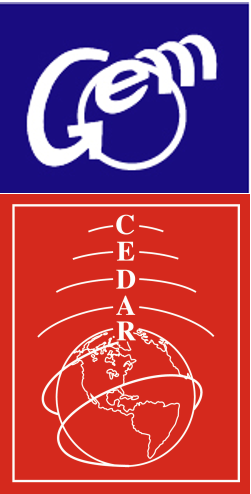Difference between revisions of "2013 GEM-CEDAR Workshop"
m |
m |
||
| Line 1: | Line 1: | ||
[[Image:GEM-CEDAR.png|100 px]]<big>''' June 22-24, 2013, Boulder, CO'''</big> | [[Image:GEM-CEDAR.png|100 px]]<big>''' June 22-24, 2013, Boulder, CO'''</big> | ||
| + | |||
'''Organizing Committee''' | '''Organizing Committee''' | ||
Revision as of 14:22, 10 January 2013
Organizing Committee
Larry Lyons (Chair), Joe Baker, Barbara Emery, Masha Kuznetsova, Wenhui Li, Elizabeth MacDonald, Anthony Mannucci, Naomi Maruyama, Joshua Semeter, Hui Zhang
Typically, the ionospheric and thermospheric response to magnetospheric inputs is modeled without inputs that describe the real distribution of large- and meso-scale electric fields relative to precipitation features and without self-consistent structuring of the ionosphere and thermosphere. Furthermore, magnetospheric dynamics is often treated with the ionosphere and its conductivity and particle sources being simply a boundary condition. However, the true system works together as a whole, and much about the structure and dynamics of the Magnetosphere, Ionosphere, and Thermosphere (MIT) is a result of their mutual coupling. New instrument facilities and model developments provide the exciting and unprecedented opportunity for comprehensive study of the fully coupled MIT system. Coordination between the various observations, of the observations with modeling, and between the magnetosphere and ionosphere/thermosphere research communities is essential.
A critical step toward making progress on MIT coupling can be accomplished by bringing together, on a regular basis, the traditionally separated GEM and CEDAR communities to discuss issues of mutual interest concerning the coupling between the magnetosphere and thermosphere-ionosphere. As such, the GEM and CEDAR steering committees have therefore decided that a joint GEM-CEDAR mini-workshop be held the weekend between the GEM and CEDAR summer workshops. The goal of this mini-workshop is to motivate progress in our understanding of the very many aspects of the geospace environment that involve the full MIT system and for which coordinated study can potentially lead to substantial progress beyond that which can be achieved by each community individually. We thus ask speakers to keep in mind the goals of educating the full MIT community on coupling phenomena and of motivating future research where the coupling is crucial. Below is a plan of topics selected to guide the workshop.
A. Dayside MIT response to transient solar wind, bow shock, and magnetopause phenomena
1. Energy and mass transfer through the magnetosheath and magnetopause associated with transients and the generation of magnetic field-aligned currents.
2. Impacts on the dayside IT system produced by transient field-aligned currents (e.g., Joule Heating, traveling ionospheric disturbances (TIDs), gravity waves, changes in thermospheric O/N2 ratio, current closure, outflow)
3. Magnetosphere-ionosphere mapping of transient features and mutual MIT coupling along magnetic field lines.
B. Structure and dynamics of polar cap ionospheric convection and plasma
4. Large-scale and mesoscale structure and dynamics of polar cap ionospheric convection: description, causes, relation to aurora features, and ion-neutral coupling effects.
5. Production and transport of polar ionospheric plasma structures: tongue of ionization, polar cap patches and blobs, generation of irregularities, etc.
6. Characterization of polar ion outflow and implications for modulating magnetospheric dynamics.
C. Active MIT coupling on closed magnetic field lines
7. Meso-scale auroral and convection disturbances in the nightside auroral zone and their relation to larger scale features: poleward boundary intensifications (PBIs), auroral streamers, substorms, omega bands, etc.
8. MIT coupling within auroral and sub-auroral regions; the plasmapause boundary layer, and troughs, region-2 currents, the Harang region, Sub-Auroral Polarization Stream (SAPS), etc.
9. Response of the nightside IT system to magnetospheric dynamics: the neutral flywheel, Joule heating, TIDs and atmospheric gravity waves, generation of subauroral ionospheric irregularities, etc.
10. Response at low and equatorial latitudes, such as related to penetration and shielding electric fields and their relative magnitudes with respect to dynamo electric fields.
D. Coordinated use of space-based RBSP/THEMIS and ground-based observations to address geomagnetic storm phenomena, including ring current and radiation belt formation, and plasmasphere evolution
11. Current understanding of the primary mechanisms responsible for formation of the ring current, plasmasphere, and radiation belts.
12. Influences of mesoscale flow channels and R2 current coupling on the formation of the ring current, plasmasphere and radiation belts.
13. Models predictions, their validity, and why do we care
14. Thermosphere-ionosphere stormtime phenomena, and how they relate to and couple with large- and meso-scale features of auroral and sub-auroral disturbances, and the ring current and radiation belts.
E. Coordinated model-data studies to support new and innovative CEDAR/GEM science
15. Current approaches for parameterizing active MIT coupling in geospace models and their assumptions and limitations (e.g. Robinson formula, the Knight relation, disturbance characterization, etc.)
16. Contributions of MIT coupling processes to important features (e.g. location of the open closed boundary, cross polar cap potential drop, particle precipitation boundaries, etc.), including model predictions and comparisons/constraints with observations.
17. Understanding basic magnetospheric high-latitude inputs to the IT system such as Poynting flux, electron and ion precipitation power, Joule heating, and electric potential distribution.
18. Coordination and assimilation of calibrated IT measurements on regional and global scales for maximizing new scientific understanding: All-Sky imagers, spectral imaging, Fabry-Perot Interferometers (FPI), lidar, incoherent scatter radar (ISR), HF radar (SuperDARN), ionosondes, magnetometry, AMPERE field-aligned currents, GPS-TEC measurements, etc.
